Displaying items by tag: Round Ireland Yacht Race
RORC Chief To Contest Round Ireland Yacht Race
Michael Boyd, the Commodore of the Royal Ocean Racing Club and current holder of the Commodore’s Cup, will return to compete in the 2016 Volvo Round Ireland race, marking the 20th anniversary of his win, with many of the same crew from his 1996 winning yacht, Big Ears.
The 18th Volvo Round Ireland Yacht Race is set to be one of the most heated editions in the race’s history say organisers with a number of prestigious international sailing champions announcing they will contest this year’s edition.
Michael Boyd's choice of a J/35 as his first serious offshore racer was a shrewd decision 20 years ago. He won the Round Ireland in style with Big Ears and more recently the J/35 model has been one of the few exceptional boats to be inducted into American Sailing's Hall of Fame. In the 1996 race Boyd and his crew, minus one removed to hospital off Kerry with fractured ribs, played every tiny gain to beat Roy, Dickson's Beaumont Spirit on Channel handicap, the deciding system for determining the overall race winner.
Twenty years later, the race received a major boost before Christmas with Volvo Cars Ireland coming on board as title sponsor this year after four years without sponsorship.
Phillip Johnston has also confirmed that he will be entering the impressive Open 60 Artemis-Team Endeavour, the current holder of the Round Great Britain and Ireland Race, under skipper Michael Ferguson.
The current holder of the Fastnet Race's Roger Justice trophy Rónán Ó Siochrú has also confirmed that he will be back to contest the Round Ireland for the fourth time.
At the end of 2015 internationally renowned sailor and US businessman, George David also announced his intention to enter his yacht Rambler 88 into the 2016 race. The canting keel maxi yacht would be a strong contender to break the Volvo Round Ireland Race record of 2 days 17 hours 48 minutes 47 seconds which is held by Mike Slade in ICAP Leopard 3 achieved in 2008.
Meanwhile, following the announcement that 2016 will be the first time that multihulls will be invited to compete, Team Concise have already indicated their intention to enter their world-class fleet. Ned Collier Wakefield, Team Director and Skipper for Team Concise, has indicated that they intend entering their 3 boats into the 2016 Volvo Round Ireland – the MOD 70 and their 2 Class 40 boats.
The Race only officially opens for entries next Monday (18th January 2016), however with the quality of entries already at such competitive levels, Race organisers expect the 2016 Volvo Round Ireland to be one of the most competitive and exciting races ever, attracting serious quality sailors and some of the finest yachts from across the world.
Race organiser Theo Phelan:
“We have further expressions of interest from some really exciting names that we hope to be in a position to announce in the coming weeks. Already the competition is heating up and we expect many previous race entrants to return to contest what is set to be one of the most exciting races ever.”
“The new Volvo Cars title sponsorship is a paramount development in the expansion of the race, which allows us to plan ahead for the significant growth of the race in the coming years.”
The 2016 Volvo Round Ireland departs Wicklow Bay on Saturday 18th June 2016 with the first start at 13.00 hours.
Volvo to Sponsor Round Ireland Yacht Race in 2016
Volvo Car Ireland has added June's Round Ireland Yacht Race to its Irish sailing sponsorships. The car brand adds the 700–mile offshore race to its existing sponsorship of Ireland's other Grand Prix biennial sailing events; Dun Laoghaire Regatta and Cork Week.
While no official figure has been released, in previous years the title sponsorship of the race has been valued upwards of €50,000, according to an RTE report.
Run by Wicklow Sailing Club, the Round Ireland Yacht Race is the only RORC (Royal Ocean Racing Club) race based in Ireland and is one of the longest offshore races in the Royal Ocean Racing Club calendar, taking up to 7 days to complete. The first race took place in 1980 with only thirteen boats. Since then, held biennially, the fleet has grown steadily, attracting a record sixty boats.
The Race is regarded as near equivalent in terms of rating points to the Fastnet Race, the classic offshore race, which runs in alternate years to the Round Ireland. The course, starting and finishing in Wicklow, brings entrants through widely different sea types and coastlines, from the Atlantic Ocean to the more sheltered Irish Sea, with difficult tidal gates, particularly around the North Eastern coast and navigational challenges requiring day and night tactical decisions at every change of forecast.
The Volvo sponsorship comes at a pivotal time in the Race’s development. Last year saw the establishment of a Dún Laoghaire base through a partnership with the Royal Irish Yacht Club, providing facilities thereby allowing larger yachts to compete. Race organisers have also just announced a further expansion to include a multi-hull category for the first time ever in its 36 year history.
Since the multi-hull expansion was announced, a UK giant 70-foot trimaran is already planning to compete in the 2016 edition of the race.
Adrian Yeates, Managing Director Volvo Car Ireland commented:
Volvo Car Ireland is proud to be so closely involved with such a prestigious sailing event as the Round Ireland Yacht Race. The Volvo Ocean Race is the world’s leading offshore race and is a truly global event, involving state-of-the-art boats and high-performance competition sailing on the world’s roughest seas. The Round Ireland offers clear points of connection with Volvo’s image, including a long-term commitment to safety, a readiness for adventure and a deep passion for design.”
Race Organiser Theo Phelan says Wicklow Sailing Club is delighted to announce Volvo as title sponsor of the race:
“Volvo represents our ultimate choice of sponsor for the Round Ireland Yacht Race, an alignment of the ideologies of strength, longevity, trusted reputation and determination. Volvo has a long heritage in sailing and an intricate understanding of the sport. Over the past four years, the focus of Wicklow Sailing Club has been to develop and expand the race and Volvo has come on board at an important time in the consolidation of this expansion. 2016 is set to be an epic year for the Volvo Round Ireland Yacht Race.”
The 2016 Volvo Round Ireland Yacht Race will set sail on Saturday June 18th 2016. The Race will officially open for entries on the 18th January 2016.
Multihulls to Compete for Round Ireland Yacht Race Honours in 2016
Wicklow Sailing Club's Round Ireland Yacht Race organisers have announced that for the first time in the history of the event multihulls will be included when the 700–mile offshore classic sets sail next June. Already, a giant trimaran – similar to one that holds the current Round Ireland speed record – has expressed an interest in competing.
The UK's Ned Collier- Wakefield, Team Director and Skipper for Team Concise, has indicated that they intend entering their three boats into the 2016 Round Ireland – the MOD 70 and their twp Class 40 boats.
It's a major shot in the arm for the Wicklow club who have already signed up a world beating monohull for the 2016 race too. American yacht Rambler 88, one of the world's most sophisticated racing machines, will also be on the Wicklow line on June 18 at 2pm in what could yet be a bumper turnout for the 19th race eclipsing the 35–boat fleet that competed in 2014.
The multihull yachts will compete against each other for a new race trophy and course record. In May of this year, the Omani trimaran Musandam-Oman Sail set a new record for the circumnavigation of the island of Ireland by sail – 1 day 16 hours 51 minutes and 57 seconds - but this was not in a race setting. The Round Ireland race record (for monohulls) is held by Mike Slade who completed the race in 2 days 17 hours 48 minutes 47 seconds in ICAP Leopard 3 in 2008.
Wicklow Sailing Club organises the Round Ireland Yacht Race under the auspices of the Royal Ocean Racing Club. As in 2014, the 2016 race is being jointly hosted with the Royal Irish Yacht Club in Dun Laoghaire. This association with the Royal Irish ensures that there will be ample space for larger monohulls and now also multihulls which wish to compete in the race.
Race organisers in Wicklow are also in contact with the Multihull Offshore Cruising and Racing Association. The organisation welcomes this development and a number of boats have already expressed interest in competing in the race.
In an additional development, the race organisers are introducing another new trophy which will be awarded for the best sailing school boat on corrected time. The Round Ireland is a popular race with sailing schools and this new trophy means that they can compete against each other in a more meaningful way.
The race officially opens for entries in January 2016 but expressions of interest are welcome at this stage.
Round Ireland Yacht Race 2016 – Notice of Race Issued
#roundsireland – The 2016 Round Ireland Yacht Race is scheduled to start from Wicklow Bay at 14:00 hrs on Saturday 18th June 2016 and organisers are seeking early interest.
The Round Ireland is a biennial 704 mile circumnavigation of the island of Ireland, starting and finishing in Wicklow. The 2016 race will be the 19th of the series, with the first race having been sailed in 1980.
The race is organised by Wicklow Sailing Club, in association with the Royal Ocean Racing Club and the Royal Irish Yacht Club in Dun Laoghaire.
The race provides spectacular scenery around the coastline of Ireland. There is a series of challenging tidal gates and varying sea conditions. Finally, there is the massive welcome home at Wicklow Sailing Club.
The Preliminary Notice of Race is attached; enquiries have already been received at the race office from interested boat owners.
The Royal Ocean Racing Club has confirmed that the race will continue to merit bonus points (1.4) for participants and the Royal Irish Yacht Club will once again provide a base for those boats who wish to use Dun Laoghaire as a base.
In 2014, the overall winner was Tanit (Richard Harris and team from Glasgow), while line honours went to Monster Project (Andy Budgen and local WSC sailor David Ryan). The overall record of 2 days 17 hours 48 minutes 47 seconds is held by Mike Slade in ICAP Leopard 3 achieved in 2008.
The race officially opens for entries in January 2016 but seek early enquiries. Download the preliminary NOR below.
Round Ireland Yacht Race – Where Next? What Next?
#roundireland – The biennial Round Ireland Race from Wicklow is the jewel in Ireland's offshore racing crown. It may only have been established as recently as 1980, but now it is a classic, part of the RORC programme, and an event which is very special for those who take part. In fact, for many Irish sailing folk, having at least one completed Round Ireland Race in your sailing CV is regarded as an essential experience for a well-rounded sailing life. Yet despite fleets pushing towards the 60 mark in the 1990s, even before the economic recession had started tobite the Round Ireland numbers were tailing off notwithstanding the injection of RORC support, and the more recent bonus of it carrying the same points weighting as the Fastnet Race itself. At a time when the basic Fastnet Race entry list of 350 boats is filled within six hours of entries opening for confirmation, and when the Middle Sea Race from Malta has confidently soared through the 120 mark, while the 70th Sydney-Hobart Race in seven weeks time will see at least a hundred entries, the Round Ireland Race fleet for 2014 was only 36 boats, of whom just 33 finished. W M NIXON wonders how, if at all, this situation can be improved.
"The Round Ireland Race is the greatest. Why don't more people know about it? Why aren't there at least a hundred top boats turning up every time it starts? It's a marvellous course. We had great sailing and great sport. Can somebody tell me why a genuine international offshore racing classic like this has been going on for 34 years, and yet in 2014 we see an entry of only three dozen boats?"
The speaker isn't just any ten-cents-for-my-opinion waterfront pundit. On the contrary, it's Scotsman Richard Harris, skipper and part-owner with his brother of the potent 1996 Sydney 36 Tanit, the overall winner of the Round Ireland Race 2014. And he's asking these questions as someone who has raced with success in both the Fastnet and Sydney-Hobart Races, and has campaigned his boat at the sharp end of the fleet with the RORC programme from the Solent, and in any worthwhile offshore racing he has managed to find in his home waters of Scotland.
Harris is getting into fine form, as we're at the Tanit table for Wicklow Sailing's Club's Round Ireland Prize-giving Dinner-Dance in the Grand Hotel in Wicklow town last Saturday night. With a boxload of trophies for Tanit to collect, anyone would be in exuberant spirits. But his views on the quality of the Round Ireland Race are clearly thought out and genuinely held, and he is enthusiastically supported by his navigator, Richie Fearon.
Fearon is the man to whom the Tanit crew give the lion's share of the credit for their success, which was achieved by just six minutes from Liam Shanahan's J/109 Ruth from the National YC in Dun Laoghaire. He was the only one in Tanit's crew who had done the race before, and in an all-Clyde lineup, his was the only Irish voice, as he sails from Lough Swilly YC in Donegal. His previous race was in 2010 with the Northern Ireland-based J/124 Bejaysus (Alan Hannon), which finished 7th overall. But for the Derry man, second time round made the course if anything even more interesting.
"You get a wonderful sense of the race progressing all the time, of moving along the course" says Fearon. "In the Fastnet, for instance, there are periods when you feel as though you're sailing in a sort of limbo. But in the Round Ireland, you're always shaping your course with the next rock or island or headland or wind change or tidal time in mind. There's a fascinating and challenging mix of strategy and tactics and navigation and pilotage, all of which results in one of the most interesting distance races in the world. They really should get more people to do it. It gives a wonderful feeling of achievement and completeness when you just finish the course. And it's even better if you do well, as we felt we'd done in 2010. But believe me, winning overall, and in a boat as interesting as this with a crew of guys as good and as friendly as this, that's the best of all!"
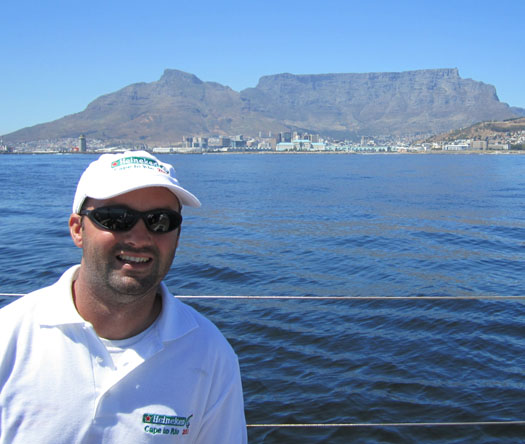
Richie Fearon of Lough Swilly YC, seen here kitted up off Cape Town for the Transatlantic race to Rio, navigated Tanit to the overall victory in the Round Ireland 2014
So how do you explain to such people, people who have become Round Ireland enthusiasts with all the zeal of recent converts, just why it is that Ireland's premier offshore event can barely attract a viable quorum when the yacht harbours of Europe are bursting with high-powered offshore racing boats which are constantly on the lookout for events worthy of their attention, not to mention commercial offshore racing schools and training programmes which need events like the Round Ireland Race to stay modestly in business?
How indeed, when we already have enough difficulty in explaining it all to ourselves. Inevitably, we have to look at the history, and the setting of that history. The last time I was at the Round Ireland Prize-Giving Dinner-Dance in Wicklow, there'd been enough participants from my home port of Howth in that year's race to make it worthwhile for us to hire a bus to go down through the Garden County for the party. We were in the midst of the Celtic Tiger years when people's expectations were becoming very pretentious, and I remember two foodies seated nearby in the bus pompously hoping to high heaven that the evening's meal wouldn't be the inevitable rural feast of beef or salmon.
But the charm of Wicklow town is that, though it's barely a forty minute drive from the capital, it is very much of the country - l'Irlande profonde as you might say. 'Tis far you are from big city notions of fancy menus to appeal to jaded metropolitan taste-buds. So it was indeed beef or salmon. Not that it really mattered that much to the crowd on the bus from Howth. They were well fuelled with on-board liquor by the time we got there, and the return journey in the small hours was made even longer by the need for frequent comfort stops, thus all they'd needed in the meal was absorbent food to mop up the booze.
Some things have changed greatly in the past few years, not least that there was so little Howth involvement in 2014's race that one very modest car would have done to get all the participants to last Saturday night's prize-giving dinner dance in Wicklow. But some things, thank goodness, don't change. It was still beef or salmon. And very good it was too, as salmon is excellent fish if you don't try to pretend that it's steak and grill it. That brings out its least attractive taste elements. But a baked darne of salmon with a well-judged sauce, such as we had last Saturday night, is a feast for a king. And I gathered the roast beef was very good too.
But it all reinforced the feeling that we were in the biggest hotel – the only hotel? - in a small Irish country town. Yet apart from the sailors at the night's event, there was nothing to suggest that Wicklow is a port, for there's something about the layout of the place which makes the harbour waterfront wellnigh invisible unless you seek it out. It's a delightful surprise when you do find it, but it's very much a little working port, rather than a natural focus for recreational boating and the biennial staging of one of the majorevents in the Irish sailing calendar.

You almost have to take to the air to see that Wicklow is a little port town, for as this photo reveals, the main street turns its back very decisively on the workaday harbour in the Vartry River.
It was back in 1980 that Michael Jones of Wicklow Sailing Club took up boating magazine publisher Norman Barry's challenge for some Irish boat or sailing club, any maritime-minded club at all, to stage a round Ireland race. Jones went for the idea, and Wicklow have been running it every other year ever since. It may be the jewel in Irish offshore sailing's crown. But in Wicklow's little sailing club, it is the entire crown, and just about everything else in the club's jewel and regalia box as well.
Whether or not this is good for the general development of sailing in Wicklow is a moot point, but that's neither here nor there for the moment. What matters is that as far as the growth and development of the Round Ireland Race is concerned, in the early days of the 1980s the fact that Wicklow was a basic little commercial and fishing port with only the most rudimentary berthing facilities for recreational boating didn't really matter all that much, as most other harbours in Ireland were no better.
In 1982, the great Denis Doyle of Cork decided to give the race his full support with his almost-new Frers 51 Moonduster. Denis was someone who strongly supported local rights and legitimate claims, and he reckoned that the fact that Wicklow Sailing Club had filled the Round Ireland Race void, when larger longer-established clubs of national standing had failed to step up to the plate, was something which should be properly respected. So in his many subsequent participations in the Round Ireland Race, Moonduster would arrive into Wicklow several days in advance of the start, she would be given an inner harbour quayside berth of honour in a place as tidy as it could be made in a port which seems to specialise in messy cargoes, and Denis and his wife Mary would take up residence in a nearby B & B and become Honorary Citizens of the town until each race was started and well on its way.
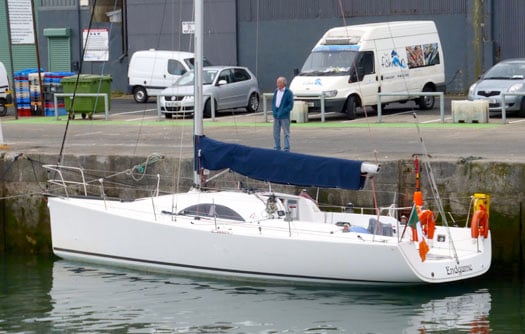
Like father, like son. Denis Doyle's son Frank's A35 Endgame from Crosshaven berthed in Wicklow waiting for the start of the Round Ireland Race 2014, in which she placed fourth overall and was a member of the winning team for the Kinsale YC Trophy. Photo: W M Nixon
It was an attitude which they brought to every venue where Moonduster was raced. The Doyles believed passionately that boosting the local economy should be something that ought to be a priority in any major sailing happening, wherever it might be staged. Denis had been doing the biennial Fastnet regularly for many years before he took up the Round Ireland race as well, and for a longtime beforehand he and Mary had also had the Honorary Citizen status in Cowes, as he would make a job of doing Cowes Week beforehand, living in digs in the town, while at race's end in Plymouth, there'd be a local commitment as well, albeit on a smaller scale.
This was all very well for Wicklow and the Round Ireland in the circumstance of the 1980s, but by the 1990s other ports were developing marinas and providing convenient facilities, yet Wicklow stubbornly stayed its own friendly but inconvenient self. When we look at the geography of the harbour, we can see why, and see all sorts of things that might have been done differently a very long time go.
For instance, when the Vikings were first invading and intent on making Wicklow one of their key ports, it could have been developed in a much more useful way if only the native Irish had made them welcome. Can't you just see it? "We'll overlook the rape and pillage for now, lads, these guys represent substantial inward investment". Just so. Had there been that far-sighted attitude, the locals could have invited the men in the longships to come on up the River Vartry, and into the magnificent expanse of the Broad Lough. What a marvellous vision that would have revealed. With some minor rock removal and a little bit of dredging in the entrance, it could be a wonderful extensive natural harbour in a beautiful setting. Had that happened, just think how differently the facilities of modern Wicklow harbour might now be.
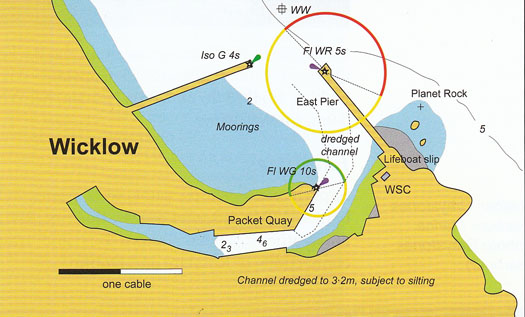
The navigable part of Wicklow Port as it is today. The water does not really come to a sudden straight-line stop as shown on the left – that's just the bridge. Plan courtesy Irish Cruising Club
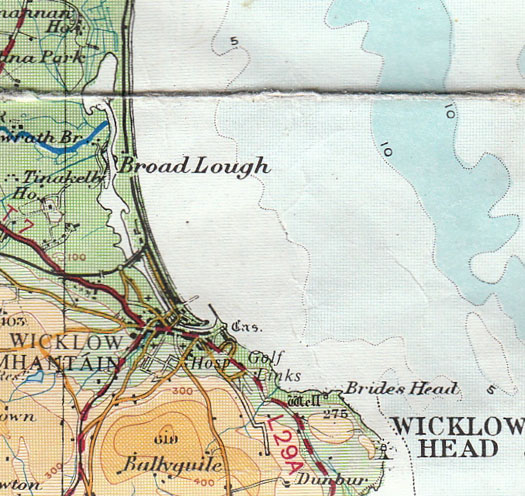
The bigger picture. Had the Vikings not been stopped such that they had to establish their settlement at the mouth of the Vartry River, they might have been able to create a much larger harbour settlement further in around the shores of the Broad Lough, with obvious advantages for Wicklow Port as it might have become today
Instead, the Vikings struggled ashore on the first available landing place at the first bend of the river, and established a beach-head which became such a successful little fort that eventually they were able to burn their boats. But by thattime, they were totally committed to having Wicklow town in its present cramped location. Access to the Broad Lough at high water (there's a very modest tidal range tidal) was soon restricted by the bridge, and then other river crossings, such that today nobody thinks of it as a potential harbour at all, if they ever did.
But meanwhile the current inner harbour is a cramped and dirty river which seems to be ignored by the town as much as possible, such that even the Bridge Tavern, the birthplace of Wicklow's most famous seafarer, Captain Robert Halpin of SS Great Eastern and trans-oceanic cable laying fame, turns its back firmly on the port. And as for the outer harbour, while it's a delightful place on a summer's day, it is not a serious proposition for berthing a large fleet of boats preparing for a major 704-mile offshore race, but people have to make do with it as best they can.
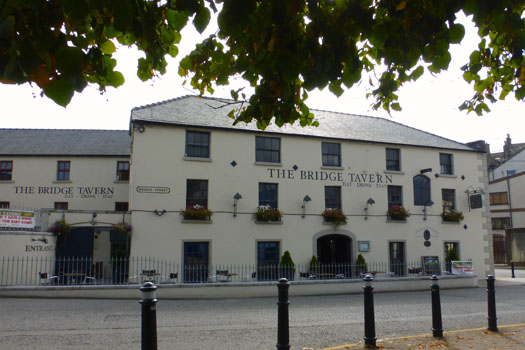
Despite being the birthplace of the most famous Wicklow seafarer, Captain Robert Halpin, the Bridge Tavern turns its back on the harbour. Photo: W M Nixon
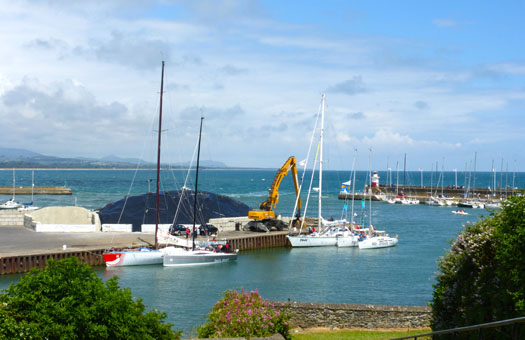
Wicklow's Outer Harbour on the morning of the Round Ireland race 2014 is a lovely sunny spot..............Photo: W M Nixon
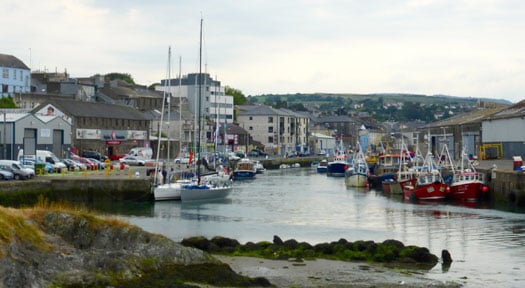
....but it is the inner harbour, shared with fishing and other commercial craft and assorted non-maritime quayside businesses, which will shelter the fleet preparing for the Round Ireland Race. Photo: W M Nixon
It was in the 1990s when the Round Ireland fleet was at its peak that the problems with the harbour's limited facilities were at their most acute, and it may be dormant memories of those difficult conditions which contribute to today's shortage of enthusiasm for the race. Back in the 1990s, the average cruiser-racer was not kitted out as a matter of course to RORC requirements, thus those undergoing their first scrutiny in order to be allowed to race round Ireland had to get to Wicklow several days in advance, and then often spendmoney like water to get up to scratch, the necessary bits and pieces being supplied by chandlers' vans parked on the quay.
It was crazy, not unlike a waterfront version of Ballinasloe Horse Fair - all that was missing was Madame Zara in her shiny caravan giving out nautical horoscopes in sepulchral tones for the wannabe Ireland circumnavigators. Perhaps she was there, but the two times I was going through the process with my own boat, it was so hectic I wouldn't have noticed. All I wanted to do was get to sea and away on the race, and get the filth of Wicklow harbour washed off the boat as soon as possible, as we'd drawn the short straw and had been berthed right in against the quay, so everyone has used our boat as a 35ft doormat on their way across to their own craft.
But the finish of the race at Wicklow – now that was and is completely different. The place seems to have transformed itself while you've been away bashing through sundry waters and a lot of the Atlantic in the intervening five days. Everyone is feeling like a million dollars, and Wicklow seems the only proper place in the whole wide world to finish a major offshore race. And as for the Round Ireland Prize Giving Dinner Dance, the venue of the Grand Hotel and beef or salmon for the meal is all part of the formula, it's central to the mystique of this extraordinary event.
In the days of the big entries with massive sponsorship from Cork Dry Gin, the prize-giving was Dublin-centred even if the race had started and finished in Wicklow. And the big bash in the city would start with a huge reception leading on into a gala dinner (I don't remember much dancing) in a glitzy Dublin hotel. In truth, it seemed a bit remote from little boats making their ways alone or in ones and twos back into Wicklow after the profoundly moving experience of racing right round our home island.
By the time you'd done all that, only others who have done the same could truly share your feelings about the experience. Big parties in anonymous city hotels were not the ideal setting for the Autumnal prize-giving and de-briefing. Thus the contemporary final hassle of getting down to Wicklow for the Round Ireland Dinner on a black November night in a veritable deluge of a downpour could be seen as the last stage of a long weeding-out process.
But once you're into the Grand Hotel and the party is under way, it's magic and the camaraderie really is quite something. Old rivalries and grievances fade away. It is also, to a remarkable extent, a family gathering – the number of family crews involved is surely exceptional. And the tone of it for 2014 is set by the presence of the winner of the KYC Trophy for the best three boat team, for the winners had as their top-placed boat the A35 Endgame, fourth overall and owner-skippered by Frank Doyle RCYC, son of Denis and Mary Doyle.
However, inevitably the status of the race and its future development and expansion is something which just won't go away. Any doubts about its importance were soon dispelled by considering the special guests at the dinner, as they included the President of the Irish Sailing Association David Lovegrove, the Vice Commodore of the Royal Ocean Racing Club Michael Boyd of the RIYC, and the Commodore of the Royal Irish Yacht Club, Jim Horan, whose club in 2014 was for the first time in association with Wicklow Sailing Club on the Round Ireland Race. The RIYC acted as hosting club in Dun Laoghaire for visiting boats which didn't want to go on down to Wicklow until shortly before the start, but wished toavail of modern marina facilities and the amenities of a large sailing port in the meantime.
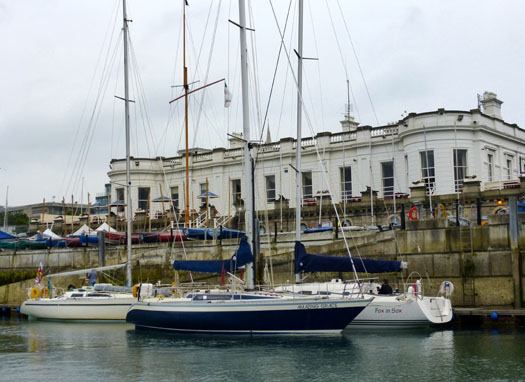
The switched-on crews going to Dun Laoghaire before the start of the Round Ireland Race 2014 knew that the best approach was to make themselves known at the Royal Irish YC and get a berth there, instead of allowing their boats to be banished to the "Siberia" of Dun Laoghaire Marina's remote visitors berths. Photo includes the MG38 McGregor IV from Essex which finished tenth overall (left), and the Oyster 37 Amazing Grace from Kerry, which had been in the frame but was forced to retire with equipment failure. Photo: W M Nixon
It was a partnership with potential, but it will need to be worked on. For although boats from other parts of Ireland knew that on arrival in Dun Laoghaire the secret of being well looked after was to make your number directly with the RIYC, boats from further afield coming into Dublin Bay tended to contact the marina, and thus they were stuck into Dun Laoghaire Marina's absurd visitors' berths, which are right at the very outer end of the pontoons, way out beyond acres of currently empty berths, such that it's said that anyone on them is one whole kilometre's walk from dry land.
Before the Round Ireland Race, the eventual winner Tanit was brought up from the Solent to Dun Laoghaire by a delivery crew who contacted the Marina Office, and she was stuck out in the Siberia of those Visitors Berths. It did mean that when she was first properly seen in Wicklow Harbour on the morning of the race, her impact as clearly an extremely attractive and very sound all round boat was all the greater. But nevertheless, if that is Dun Laoghaire Marina's idea of making visitors welcome, then they need to do something of a reality check, and it was a telling reminder that many Dun Laoghaire and Dublin Bay sailors are so absorbed in their own clearly defined and time-controlled activities afloatthat it leaves them with only limited attention for events outside their own sphere of interest.
As for Dun Laoghaire's general public, is there any interest at all? If the start of the Round Ireland Race was shifted to Dun Laoghaire, as some suggest, do you think the vast majority of the locals would take a blind bit of notice? At least in Wicklow they do make a bit of a fuss on the day of the start, with a community-sponsored fireworks display the night before.
In a final twist, in setting up the new Wicklow-Dun Laoghaire relationship, nobody had thought of the Greystones factor. Most had been unaware that the new Greystones marina is unexpectedly very deep. But such is the case, as I learned on Saturday night from the man from Newstalk. It's one of the reasons it cost the earth to build the little place. But it did mean that, in the buildup to the Round Ireland Race, while two of the deepest boats, the Volvo 70 Monster Project chartered by Wicklow's "Farmer" David Ryan, and the Farr 60 Newstalk, were unwilling to berth in Wicklow itself, they'd only to go a few miles north to find a handy berth in Greystones, where they were still very much in Wicklow county. There, they were the focus of much attention. For as we've discovered at Afloat.ie, if we lead a story #greystones, the level of interest is amazing.
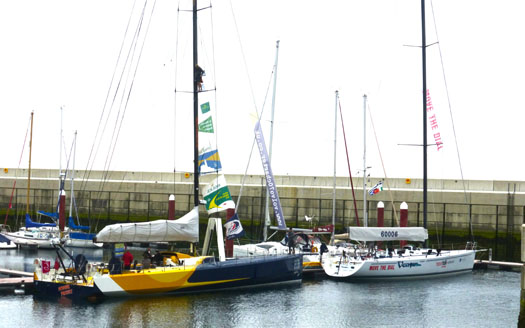
The exceptionally deep water in Greystones Marina provided trouble-free berthing for the Volvo 70 Monster Project and the Farr 60 Newstalk. Photo: W M Nixon
Perhaps after their attendance at the Round Ireland Dinner in Wicklow last Saturdaynight, Tanit's crew now have a better understanding of why the Round Ireland Race is in its present format. And I certainly understand why the level of close personal attention which goes into the race administration by the small team in Wicklow SC running it adds greatly to its appeal for dedicated participants. Before going to Wicklow, I'd been checking with the eternally obliging Sadie Phelan of the race team whether or not Richard Harris would be there, as I had to admit I thought his boat was only gorgeous. "Of course he'll be there" says Sadie, "and I'll put you at his table".
Not only that, but the winner Tanit's table and the runner-up Ruth's table were cheek by jowl, so much so that I was almost sitting at both of them. It would have taken a team of scribes to collate all the information flying back andforth, but everything was of interest.
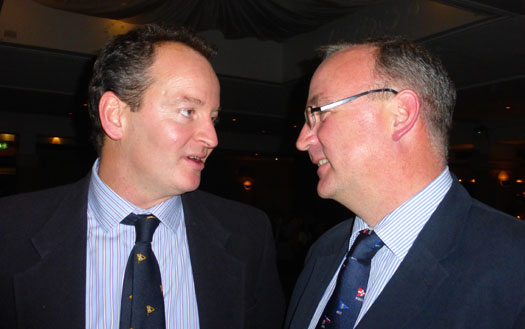
Just six minutes separated them at the end.....winner Richard Richard Harris of Tanit (left) and runner-up Liam Shanahan of Ruth at the Round Ireland prize-giving in Wicklow last Saturday night. Photo: W M Nixon
Richard (42) and his brother have owned Tanit for about twelve years, but as his brother is into gentler forms of sailing, the offshore campaigns are exclusively Richard's territory. In early sailing in the Clyde, they'd campaigned a Sweden 36 with their late father while Richard's own pet boat was a classic International OD. But as his interest in offshore racing grew, heidentified the Australian Murray Burns Dovell-designed Sydney 36 as ideal for their needs. He found there was only one in Europe, a 1996 one, little-used and in the Solent. They soon owned her, and changed her name to Tanit as the family firm is Clyde Leather, a vibrant firm which is the only suede tannery in Scotland.
Thus as raced in the Round Ireland, Tanit had the logo of Clyde Marine Leather on her topsides - a useful sideline is suede products for marine use, including a very nifty range of attractively-priced DIY kits for encasing your stainless-steel steering wheel in suede. Show me a boat which has a bare steel wheel, and I'll show you a boat which is on auto-pilot for an indecent amount of the time. But if you are doing the suede coat thing on your helm, be sure to cover the spokes as well, it makes all the difference for ultimate driver comfort.
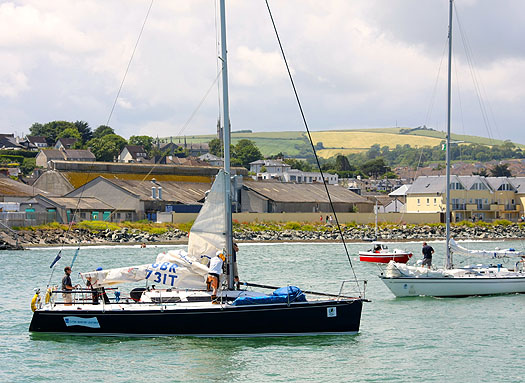
The boat from God knows where....Tanit (left) was an unknown quantity when she made her debut in Wicklow Harbour on the morning of the Round Ireland Race 2014, but father and son crew Derek & Conor Dillon's Dehler 34 Big Deal (right) from Foynes had already taken part in a couple of ISORA races, and went on to win the two-handed division and place 8th overall. Photo: Kevin Tracey
Gradually, they built up Tanit's campaigning in the Clyde, and most of the crew who currently race the boat have been together for seven years. They also chartered a boat to do the Hobart Race of 2008, but as Scottish offshore racing numbers declined, they decided to give it a whirl with the RORC fleets in the English Channel by moving Tanit down there. They found that the programme of concentrated doses of large-fleet intense offshore racing, all taking place at a venue two hours' flight from Glasgow, suited them very well – they could be totally domesticated when at home without the distraction of the boat being just half an hour's drive down the road.
The Sydney 36 of Tanit's type ceased production in 1997, the Sydney 36 you'll tend to come across now on Google is a new 1998 design. So when Tanit's rudder was wrecked after the 2011 Fastnet (a good race for them), it was something of a disaster as a replacement rudder could no longer be supplied off the shelf. It was even more of a disaster for the unfortunate woman who was driving her five-day-old Range Rover around the boatyard in Southampton where Tanit had been hoisted after returning from the Fastnet finish in Plymouth, for not only was her absurdly big shiny new vehicle severely damaged in somehow colliding with the rudder of the Scottish boat, but it turned out that an inevitably custom-built replacement would cost a cool 35K sterling for her insurance company, as that was one very special rudder.
It was a disaster all round, for by the time they'd identified a high tech builder of sufficient repute prepared to build the new rudder, they had missed most of the 2012 season. Then the 2013 Fastnet Race had too much reaching to suit them, as Tanit is at her best upwind and down. So with Richard's brother making louder noises about selling Tanit in order to suit his more sybaritic preferences afloat, the Round Ireland Race 2014 came up on the radar as being an opportunity for what might well be the last hurrah with a much-loved boat.
They needed a navigator, and preferably one with some experience of the Round Ireland course. Fortunately John Highcock of Saturn Sails in Largs, who regularly races with Tanit as one of those ace helmsmen who can seem to smooth the sea, had sailed with Richie Fearon and suggested him with the highest possible recommendation, so the Swilly man was brought on board.
The rest of the crew were complete round Ireland virgins, but they found the race suited their style and level of sailing very well indeed. In any Round Ireland Race, seasoned observers can usually identify beforehand the half dozen or so boats which will be serious contenders for the overall handicap prize, but which one actually wins will depend on the way the chips fall. But Tanit was something of an unknown, a wild card. Yet it wasn't very far into the race before it became clear that this was a good boat on top of her game, if things came right she'd the makings of a winner.

Tanit settling in after the start. The quicker they got south, the sooner they got back into the sunshine........
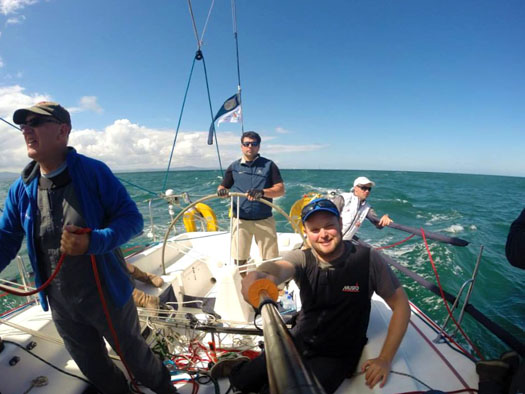
....and nearing the Tuskar Rock on the Saturday evening, they were back in sunshine, and well in contention on the leaderboard.
Within the limits of having a sensible boat which professionals would describe as a comfortable cruiser-racer, they campaign flat out. All meals are built around expeditionary and military Ration Packs, which can be quite expensive to buy in ordinary circumstances, but if you can show they're going to be used for a worthy objective, it's possible to swing a deal, and as Richard's wife Vicky is a physiotherapist who is involved with military reserves, the value of Tanit's campaigns is accepted in the right places. The result is a nourishing supply of reasonably attractive easy-prepare instant food which, as Richard reports still with some wonderment, makes no mess at all in and around the galley, yet keeps the crew on full power.
By the time they got up off the Donegal coast, Tanit was right in there, battling with the defending champion, the Gouy family's Ker 39 Inis Mor, for the overall handicap lead, while up ahead the two biggies, Teng Tools (Enda O'Coineen and Eamonn Crosbie) and the Volvo 70 Monster Project, with David Ryan of Wicklow, kept finding new calms as they tried to shake off the smaller craft.
It was a slow race, but Richie Fearon managed to place Tanit so that she stayed ahead of a calm up in his home waters, and was keeping station on Inis Mor very handily indeed, while the gap with boats astern widened all the time. Or so it seemed. But then the Round Ireland Race pulled one of its regular tricks, and Liam Shanahan and his team on the J/109 Ruth began to shift before they'd even got past Tory Island, and they appeared to carry a useful breeze and a fairtide the whole way from Donegal into the Irish Sea, or at least that's how it looked to the rest of the fleet.
But in closing in over the final stage from Rockabill to Wicklow, navigator Fearon – who was incubating a nasty virus which required antibiotic treatment for a week after the race - convinced Tanit's skipper that they should stay offshore, while Ruth – which seemed to have the race nicely in the bag – followed the Irish habit of hugging the coast. Inis Mor was already finished on Friday morning, but Tanit knew she was beatable by them, and when they came across the line at 1030, it was to move into the CT lead. And going offshore proved to have been their win move.
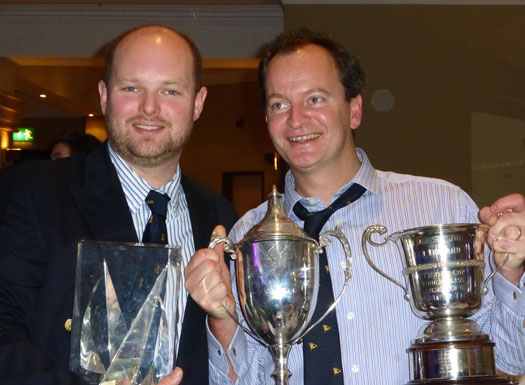
Trophies of the chase – crewman Chris Frize (left) and skipper Richard Harris with some of Tanit's prizes in Wicklow last Saturday night. Photo: W M Nixon
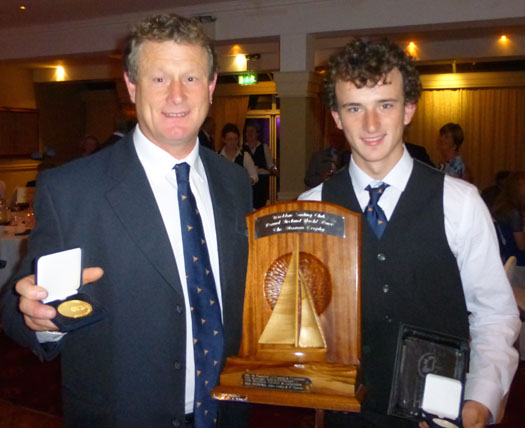
Family effort. Father and son team of Derek and Conor Dillon from Listowel in Kerry (they sail from Foynes) won the two-handed division with their Dehler 34 Big Deal, and placed 8th overall. Photo: W M Nixon
It was a time of screaming frustration for Ruth. She'd been crawling along near Bray Head, barely 15 miles from the finish, as long ago as 0700. She rated only 1.016 to the 1.051 of Tanit. A finish in the middle of lunchtime would do fine. It was so near. It was so far. Finally they got to Wicklow, but Tanit had them beaten by six minutes. Then for the Scottish boat there was just the chance that Ian Hickey's very low-rated veteran Granada 38 Cavatina might do it again. But the wind ran out for her too. Meanwhile Frank Doyle's Endgame came in at mid-afternoon to slot into fourth on CT behind Inis Mor, but Cavatina was fifth, all of five hours corrected astern of Tanit. The Scottish boat was now unbeatable leader.
Tanit's crew for this classic sailing of a true offshore classic was Richard Harris, Richie Fearon, John Highcock, Alan Macleod, Chris Frize, Andy Knowles and Ian Walker. They've a lovely boat of which they're justifiably very fond, but reality has intruded, and now she is indeed for sale. The price is 48K sterling which seems to me very reasonable when you remember that she is remarkably comfortable to sail, that sails and gear have been regularly up-dated, and that we know for certain that the rudder alone is worth 35K.......She's conveniently located for an Irish potential owner, as she's currently ashore in Glasgow. Certainly she has a performance weakness, for as Richard admits, she'll easily get up to 7 knots on a reach, but stubbornly stays there and goes no faster, yet if you harden on to the wind, she'll still be doing 7 knots. But if you go downwind, then whoosh – it's a horizon job on most other boats. Be careful what you wish for, though. With a boat like Tanit in an average fleet, there'll be no excuse for not doing well......
The rest of the trophy placings are here, and on Saturday night they were one lovely compact crowd of people. The family emphasis was inescapable, and it was a particular pleasure to meet the Kerry duo, father and son crew Derek and Conor Dillon from Listowel, who sail out of Foynes in their Dehler 34 Big Deal. In 2015, they plan to take on the two-handed division in the Fastnet, so getting 8th overall and winning the two-handed class in the Round Ireland 2014 was part of a very useful campaign trail.
Finally, as to how to keep the Round Ireland race's distinctive Wicklow flavour while allowing the entry numbers enough room to comfortably expand, it's such a tricky question that it will require a radical solution. A very radical solution. The mistakes of the Vikings must be undone. The Vartry entrance must be dredged, The bridges must all be removed. And the Broad Lough must be tastefully developed to give Wicklow the harbour it deserves, and the Wicklow Round Ireland Race the facilities it needs to cater for a fleet of a hundred and more boats. Simple, really.
ROUND IRELAND RACE TROPHY WINNERS 2014
Line Honours: Denis Doyle Cup - Monster Project (David Ryan, WSC)
IRC Class CK: CK Cup – Monster Project
IRC Class Z: Class Z Cup - Newstalk for Adrenalin (Joe McDonald, NYC)
IRC Class 1: Tuskar Cup – Inis Mor (Laurent Gouy, CBC)
IRC Class 2: Fastnet Cup – Tanit (R Harris, SYC)
IRC Class 3: Skelligs Cup – Ruth (L Shanahan, NYC)
IRC Class 4: Tory Island Cup – Cavatina (I Hickey, RCYC)
Class 5 (Cruiser HF) – Cavatina
Class 6 (pre 1987) Michael Jones Trophy – Cavatina
Class 7 (two-handed) Noonan Trophy – Big Deal (D & C Dillon, FYC)
ICRA Trophy (best Irish boat) - Ruth
Ladies Award: Mizen Head Trophy - Pyxis (Kirsteen Donaldson)
ISORA Award – Ruth
Team Award: Kinsale YC Cup – Endgame (F Doyle), Wild Spirit (P Jackson) & Fujitsu (D B Cattle).
IRC Overall: Norman Barry Trophy – Tanit
Round Ireland Overall: Wicklow Cup - Tanit

Monster boat, monster prizes. Line honours and Class C winner David Ryan of Wicklow, who raced the Volvo 70 Monster Project to success, with Roisin Scanlon, also WSC, who crewed on the Monster during the Round Ireland Race Photo: W M Nixon
#RoundIreland - Father-and-son duo Derek and Conor Dillon have been congratulated by Foynes Yacht Club after taking the two-handed category in this year's Round Ireland Yacht Race, writes Gerry Ryan.
The Shannon Estuary team raced their Dehler 34, Big Deal, to first in IRC 7 as well second in IRC 4, where they were beaten only by Cavatina from the Royal Cork Yacht Club, skippered by Ian Hickey - a twice previous winner of the Round Ireland.
Add to this an overall eighth-place finish and their performance is testimony to the nautical skill and personal perseverance on both these intrepid sailors, the best performing entrants in the Round Ireland in FYC history.
This was no easy feat to perform for the Dillons, for the Round Ireland is a mammoth task against stiff competition, certainly not a race that you can 'rest'.
Yet despite the odds, Derek Dillon says the "high pressure and the light winds certainly favoured us for the race in accomplishing the task on Big Deal."
On Sunday afternoon 6 July, a bottle of champagne was presented to the Dillons by FYC Commodore James McCormack, who praised their expertise and hailed their result as a source of pride and a "great day" for the club.
But the season's not over yet for Derek and Conor, who are already preparing for the Fastnet Race scheduled for next month.
#roundireland14 – Richard Harris' Tanit, of the Serpent Yacht Club on the Clyde, has pipped Liam Shanahan's Ruth for the clubhouse lead in this year's incident-filled Round Ireland Race. Ruth looked all set to be the leader until a cruel combination of decreasing wind and increasing adverse tide held her up within sight of the Wicklow finish. Tanit, a Sydney 36, was safely in the club at this stage, knowing that any setback to Ruth's progress would establish them as the target boat for the rest of the fleet.
While there are boats yet to finish, Tanit is not guaranteed to be the overall winner, but as closest contender Cavatina, with a current VMG of 4 knots, needs to average over 6 knots for the remaining 70 miles, it looks likely that Tanit will be the name on this year's trophy.
Celebrations may be on hold for a while, as Cavatina has until just after 2am to reach Wicklow. It's not the forecast wind speed that will thwart Cavatin'a hopes for a threepeat, it's the direction of SSW that makes it a dead beat and thus requiring the extra distance through having to tack for the finish.
RoundIreland14 – It has been a classic Round Ireland Race. Just about everything except a gale, and even then there was some gear-breaking wind in the latter stages. But mostly, the sun shone. Or at least, there was little or no rain until Friday. And even if the wind didn't blow nearly enough, even those on the smaller boats who had committed a week's holiday time to this very special experience found they stayed within their leave limits, though only just.
When Wicklow farmer David Ryan confirmed in May that he had chartered the Volvo 70 Monster Project for the 2014 Round Ireland Race starting June 28th, he was succinct in his objectives. The bottom line was to support the Care For Shane campaign, which is raising funds for his nephew Shane Horgan, who was brain-damaged in a serious assault in 2012.
With the foundation of the plan in place, the details could be filled in. The Volvo 70 chosen was Russian, built in 2008 by Green Marine of Lymington. Owing to a shortage of funds during the race itself in 2008-2009, she didn't compete in all the legs. But once that race was over, here was this fine big Rob Humphreys design seeking a purpose, with time available to bring her up to standard. And she'd a new commercially-minded owner who cheerfully re-named the boat Monster Project, and worked on the basis of scouting out fresh fields for competition, as the Volvo World organisation was moving on to a new generation of boats in the next race.
But for round Ireland racing with fund-raising a priority, Monster Project ticked all the boxes. Nevertheless, Farmer Ryan was very realistic in his objectives. For sure, he hoped he might break the race's course record, which is a very different thing from the open round Ireland mono-hull record. But if he harboured even the slimmest hope of winning overall on corrected time, he kept it to himself. Yet he clearly stated that the main race objective was to win line honours – "first over the line for Shane". And at 18:25:25 hours on Wednesday July 2nd in a brisk southerly off the Wicklow pierheads with the enthusiastic support of the home crowd, Monster Project did that very thing.
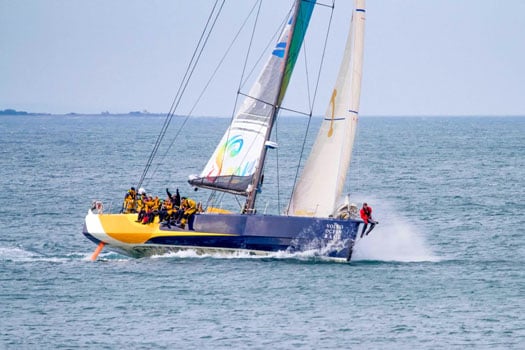
Job done. Monster Project takes line honours at Wicklow. Photo: Aidan Tarbett
As she was 70ft LOA and the next three biggest boats were "only" 60ft, it may have seemed a foregone conclusion. But the Round Ireland Race really is a case of swings and roundabouts and big dippers from time to time for every one of the 36 boats taking part. So though the Wicklow Monster may have built up a lead of 32 miles over the Open 60 Teng Tools Kilcullen (Eamon Crosbie & Enda O'Coineen) by the time she finished, she'd surely had to work for it. And had there been more fast off the wind stuff, things might have gone otherwise.
Despite the 10ft difference in length, the Open 60's potential is such that she rates an eye-watering 1.635 to the 1.6498 of Monster Project. So in rating terms the two boats were almost racing boat-for-boat, and in tactical terms that's the way Monster's 18-strong crew of all the talents had to see it.
But of course, with the predictions of light airs and calms for the first half of the week coming all too true, within 24 hours of the start it was becoming highly likely that one of the smaller boats would win, and low ratings became pearls beyond price. Observing it all and getting feedback from many sources, you became aware of the "Community of the Round Ireland Race" as the miles were slowly sailed. Their boats may have covered a wide variety of types and sizes, but the crews sharing this experience were joined together in a subtle way which gently but totally excluded outsiders.
You'd a sense of this in Wicklow as start time approached and the tension built up, with crews beginning to distance themselves from the shore crowds. Indeed, I got a blast of it in the car on the way down, listening to the Saturday morning's Down to Business programme on Newstalk, which is normally fronted by Bobby Kerr.
But as he was off to do the race on the fine big Farr 60 Newstalk for Adrenalin (chartered by Joe McDonald of the National YC), they'd a stand-in presenter. On the car radio, Kerr (a boat-owner himself) was trying to explain from the Farr 60 – with his usual zest – the special attractions of the Round Ireland Race to the American woman business journalist who was filling in for him in the studio. But he wasn't really making much progress. Her genuinely sceptical response to his enthusiasm for working coffee grinder winches and standing four hour watches 24 hours a day – and every chance of being called when you're off watch too – reminded me of the classic Bob Newhart sketch about the introduction of tobacco. The mutual incomprehension was just about total. And if Bobby Kerr can't explain the special attraction of racing round Ireland on his own radio show, then why do the rest of us even try?
The Round Ireland Race produces many imponderables. For instance, there's the matter of the new harbour and marina at Greystones finally hitting the headlines as a result of having Monster Project and Newstalk for Adrenalin based there in the leadup to the race, as Wicklow Harbour isn't really deep enough for them and both needed a pontoon berth.
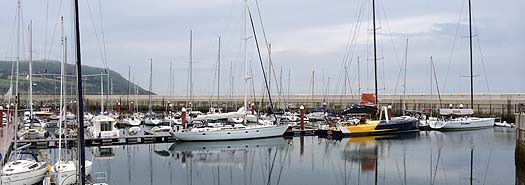
Arise, Greystones, and join the big time.....having Monster Project and Newstalk for Adrenalin in port pre-race raised Greystone's pofile something wonderful. Photo: Alan Corr
So Afloat.ie posted a pic from Alan Corr of Greystones Harbour showing the two biggies in port, and by sailing website standards it went viral. All because it's hashtagged #greystones. So be warned, in future you may find some very sleepy stories #greystones here on Afloat.ie if we hope to get them the Monster Newstalk level of attention.
But enough. Just as the sailor/spectator divide was beginning to manifest itself, I managed to get myself on board Wildwood for a quick recce. Not only was she the shortest entrant at just 30.5ft, but she was the newest with a build date of 2012. Yet in truth she was building since 2003, as this has been an extraordinary amateur design and build project, a case of good work done by stealth.
Though Wildwood sails from East Antrim Boat Club on Larne Lough, the first gleam of a notion came in the bar at Carrickfergus SC. Over a pint or three, amateur designer Richard McClure and can-do potential owner Ian Patterson sketched out ideas for a handy little dream performance cruiser-racer.
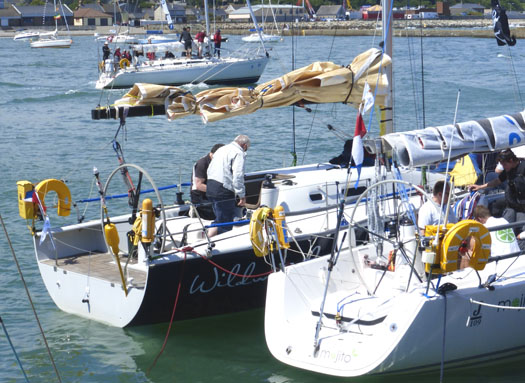
Little self-build 30-footer Wildwood (seen here outside the J/109 Mojito) came down from Larne to Wicklow for her first stab at the IRC big time. Photo: W M Nixon

Ian Patterson built Wildwood between 2003 and 2012, and they've won their class in the Scottish Three Peaks Race Photo: W M Nixon

Wildwood brought her shore support team – they came down from Larne with a couple of camper vans Photo: W M Nixon
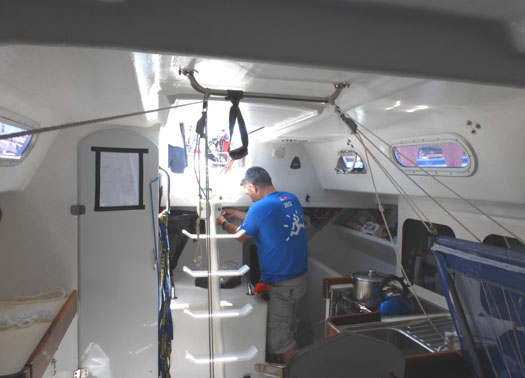
Below, Wildwood is roomy, with a highly individual layout Photo: W M Nixon

Wildwood has a substantial galley which wouldn't look out of place on a 40 footer. Photo: W M Nixon
It will be a good story to flesh out in more detail during the coming winter. Sufficient to say that she was launched in 2012 and arrived in Wicklow in June 2014 with honours already achieved by winning their class in last year's Scottish Three Peaks Race.
Nevertheless, despite the cheerful quayside support of family and friends who have stayed with the Wildwood project through its long gestation, the mood aboard was a bit subdued. The Scottish race had been on very basic handicaps, but the Round Ireland – which itself started in 1980 using a Wicklow modification of the ECHO system – is now part of the RORC programme, using strictly regulated IRC.
This new measurement routine put little Wildwood up from her notional rating of 1.02 to an official rating of 1.045. That may not seem like a huge jump, but for the crew of a little boat which prefers fast offwind stuff yet was going out to face a long beat right up Ireland's long Atlantic seaboard, it seemed like yet another mountain to climb.
But out they all go for the start, these 36 boats in all shapes and sizes, and any crewmember who denies abdominal butterflies at this time is either in denial, or so full of Stugeron they don't know what's going on below their navel.
With a decent nor'east breeze and a sluicing ebb running south, it's a tricky close reaching start at 1400 hours, but Teng Tools Kilcullen and serial overall winner Cavatina (Ian Hickey) are right there on time, and the only shunt in the body of the fleet is between western boats Lynx Clipper (Galway) and E F Collins/Amazing Grace (Tralee), with the latter returning to port to fix a fist-sized hole in her stern and set out again after some hours with a post-race protest in the offing.
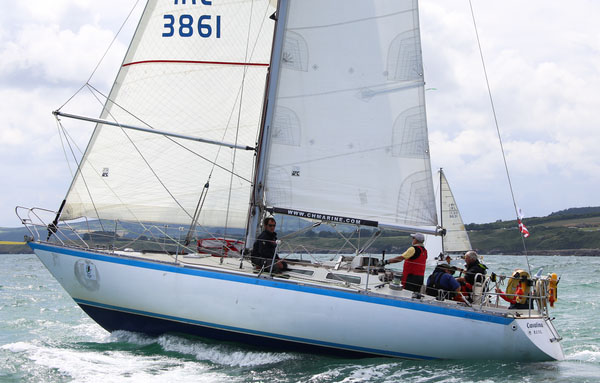
Out of the ruck of the start, the little Cavatina showed well among a raft of larger boats. Photo: David O'Brien
Coming out of the start, with boats which would emerge as performers as the race went on starting to show themselves. The Sydney 36 Tanit is left foreground, the Rodman JV 42 Phosphorus (Mark Emerson) is making hay with Code 0, the "steady Eddy" Ker 39 Inis Mor is right front, and the big Farr 60 Newstalk for Adrenalin is starting to show a performance which just kept getting better throughout the race. Photo: W M Nixon
Thanks to the Yellowbrick plotters, following the fleet has become like a computer game. If you're bored with the progress, you can always accelerate them electronically up and down along the course, with it all becoming – as the less reverent have remarked – like a pack of rats trying to get up a drainpipe.
It's when you see it reduced to symbols on a screen in the big picture that you realise how restrictive the round Ireland is for epic tactical gambles. In the Newport-Bermuda race, for instance, the 600 miles of straight line across the open ocean provides a broad canvas, and the famous Carina once notched one of her legendary wins by being all of 60 miles to the westward of the rhumb line. But in the round Ireland, only along the south coast is there a decent option for taking a real flyer, and it was there south of Youghal that Teng Tools went offshore as the wind drew sou'westerly, while the nearby and faster-to-windward Monster Project went off to close the land and cover the French Volvo 60 Libertalia and Newstalk for Adrenalin.
Monster put those two well away, but at the Fastnet she was only 20 minutes ahead of Teng Tools Kilcullen shortly after noon on Sunday, TTK coming sweetly in from seaward and doing very well in conditions which didn't really suit her at all.

Teng Tools Kilcullen at the Fastnet 21.5 hours after the start. Photo: Paul O'Flynn
In fact, if you'd set out to design a race which didn't at all suit an Open 60, then the 2014 Round Ireland would be in the top five. An awful lot of light windward work, and gates at every turn. In these conditions, a Volvo 70 is more flexible, but even so on Tuesday as Monster sat stopped off Inishtrahull, TTK was close to the southwest and energetically tacking inshore along the north coast of Donegal against a local easterly, keeping herself well in touch.
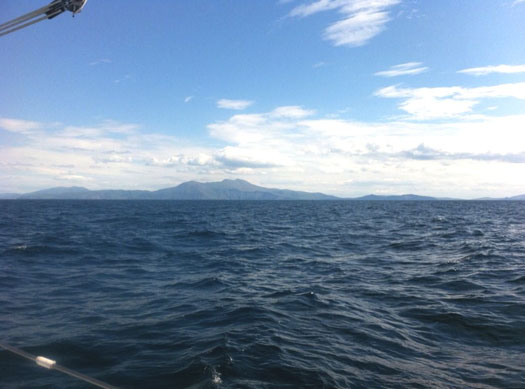
Fine day out west – the Kerry coast with the Blaskets as seen from Liam Shanahan's J/109 Ruth

Good morning, Ireland. The Scottish Sydney 36 Tanit (Richard Harris) enjoys a summer sunrise on the Atlantic coast, even if they do have to turn to windward. Photo: Roisin Harris

Even with all June's sunshine, the North Atlantic was distinctly chilly for this swim from the First 40 Arthur Logic

Downtime on the Sydney 36 Tanit out in the Atlantic. Owner Richard Harris sails under the burgee of the Serpent YC, a Scottish club founded in 1976 for sailing health professionals. Photo: Roisin Harris
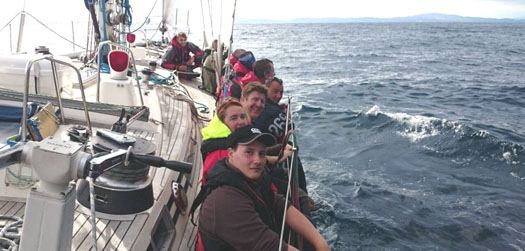
All hands to the lee rail to get a bit of heel on the hefty Swan 57 Bow Waves Racing from Galway as she makes slowly to windward off the Atlantic coast.
The two biggest boats then had an awful lot of hard work tacking through the North Channel, but astern Newstalk was getting into the groove, and by the time Monster was finishing the Farr 60 had seen off the Volvo Ocean 60, and was giving TTK a bad time.
With the new southerly filling in with gusto, the little boats still off the Donegal coast were making hay, with Cavatina coming in round Tory Island well up with the Swan 57 Bow Waves from Galway. Cavatina's crew were having the time of their lives and living well with it – they tweeted the cooking spuds which power the boat, presumably with buckets of Barry's tea. However, until Donegal the talking point had been the impressive game of catch-up being played by Brian O'Sullivan and his Tralee Bay crew in the Oyster 37 E F Collins/Amazing Grace, as they were ninth overall in IRC at one stage, and of course if their protest was upheld post-race, Heaven only knows what compensatory time would be added.
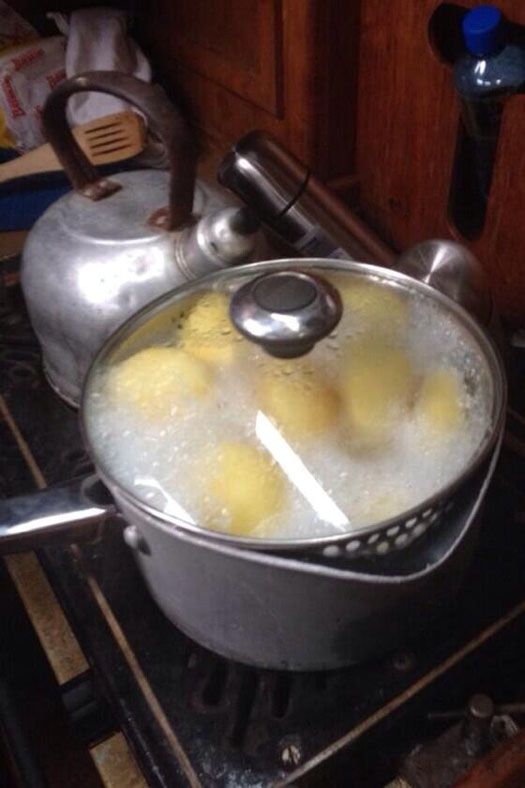
Grub up! In many years of successful Round Ireland racing, Cavatina's crew have learned the importance of feeding the inner man.
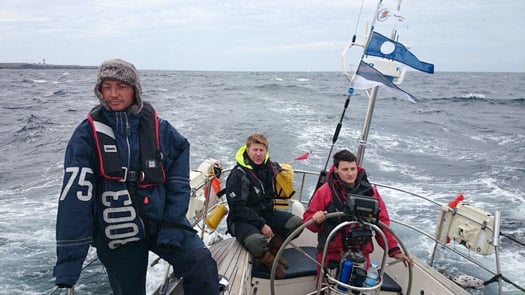
The brisk new sou'wester brought the Swan 57 Bow Waves Racing sweeping in past Tory Island, but she'd the much-smaller Cavatina in sight astern.
But that spirited performance ended with a bang on Wednesday with a broken mainboom which, together with other problems, led to their withdrawal. However, there were plenty of others to take their place in challenging for the overall lead, with Liam Shanahan and his crew from the National YC in the J/109 Ruth getting themselves firmly ahead of Frank Doyle's A 35 Endgame from Cork, while the attractive Sydney 36 Tanit from Scotland was also very much in the running.
Looking at the fleet overall as they made along the Donegal coast, there were discernible patterns emerging, with boats you'd call the "solid performers" starring on the track chart. These were boats such as Inis Mor, Tanit and Ruth which always seemed to be there or thereabouts, always plugging away and showing a clean pair of heels to the nearest-rated boats, and always well placed such that if local wind and tide conditions favoured them, they were poised to ascend rapidly to the top of the leaderboard.
As for the "sail training" vessels, in the closing stages the Jeanneau Sunfast 37 Desert Star of Irish Offshore Sailing at one stage on Wednesday found herself lying second overall to Cavatina. But with 170 miles still to go, and most of them to windward, it was going to be hard work for a keen multicultural crew of many nationalities to maintain this exalted placing.
It was Thursday morning which was crunch time. Having filled in from the south, there was a brief period in which the wind veered towards the west, and with Monster Project well finished and then Teng Tools Kilcullen, Newstalk for Adrenalin and Libertalia finishing during the night, first light saw the steady and reliable Inis Mor finishing at 04:13:56 to stake a claim which was challenged by boats such as Tanit and Ruth closing up from astern in a now-favourable tide, the tide having been against Inis Mor all the way down from Rockabill except for the last hour or so.
The challenge from a hundred miles away of Cavatina faded for a while with light airs off Belfast Lough and a foul tide in the North Channel. But in the south end of the Irish Sea and through St George's Channel, the sou'west to west breeze was holding enough to have Tanit and Ruth moving theoretically into the top slots ahead of Inis Mor. But then with the tide turning again to run north around 0900 hrs, it was to be nail biting stuff through Thursday morning.
Tanit was in by 10:00:44 hrs on Thursday, leaving the lower-rated Ruth with a mountain to climb, the tide against her and the breeze light. It was excruciating to follow, with her speed down at times to barely a knot over the ground off Greystones, and the lovely Wicklow coastline just crawling past at snail's pace. Meanwhile, far astern Cavatina was back in business with just 80 miles to sail, and a local breeze giving her better than 5 knots on the clock.
Meanwhile by 1300hrs Ruth had just 5 miles to go, and speed slowly building as the wind was generating around big clouds over Dublin.
But by just after 2pm Thursday it was clear Tanit had pipped Ruth for the clubhouse lead. Ruth had looked all set to be the leader until a cruel combination of decreasing wind and increasing adverse tide held her up within sight of the Wicklow finish. Tanit, safely in the club, knew that any setback to Ruth's progress would establish them as the target boat for the rest of the fleet. Wicklow Sailing Club could not formally announce the winner until much later on Friday as the last of the boatts finished but it was clear not even Cavatina who had until 2am on Friday could match the time of the Scottish Sydney 36.
They and all the other competitors will have this weekend to decompress and try to explain to family, friends and workmates just what this crazy Round Ireland Race thing is all about. But it isn't until the great prize giving dinner in Wicklow in the Autumn that they can all really tell the stories that just have to be told, and tell them to people who will really understand.
#roundireland14 – Round Ireland races have many twists and turns before a winner can be declared and this one is living up to this reputation. Earlier this morning it looked like Ruth was going to romp home in a decent breeze to victory. The wind and tide had other ideas and now Ruth is looking at the finish line, but from the course side, not from the comfort of the Wicklow Sailing Club Bar.
It looks like Ruth could well be denied the overall wind by the combination of light winds and a foul tide as she languishes off Kilcoole, just 7 miles from the finish. If the breeze doesn’t pick up, Tanit, the clubhouse leader, will be looking pretty, unless, and there is always a caveat, a freshening and veering breeze sweeps the smaller boats down the Irish Sea. This would put long time on the water leader Cavatina back into the mix.
There is a slight hope for Ruth – the flood tide is easing off and there is a small increase in the breeze. If she can average 6 knots and get to Wicklow by 13:53. Tight, but possible.
Next report in an hour.
Round Ireland (Thursday Dawn) - National YC's Ruth Now Favourite as Cavatina Falls Foul of Wind and Tide
#roundireland14 – In a dramatic change of fortune for the long time Round Ireland Race favourite Cavatina, Liam Shanhan's Ruth, a J/109 class yacht from the National Yacht Club, has taken over as the main contender for the overall prize in this year's Round Ireland race. Cavatina, along with many of the lower rated yachts has sailed in to a calm patch off Belfast Lough and as a result has lost any benefit gained from a favourable tide in the North Channel. With only 45 miles to go at 4am, the forecast suggests that Ruth will enjoy a fairly steady breeze of medium strength for the final fetch to the finish, while those astern will encounter less favourable winds in the last stretch down the Irish Sea.
The effect on Afloat's race predictor is remarkable. None of the lower rated boats feature in the latest prediction, as the 16 knots that Ruth is experiencing now appears to diminish in her wake, effectively creating a block behind her that will hinder the chasing boats. This will favour those boats ahead of Ruth that have finished or will finish before 10am.
So now the final Round Ireland 2014 result might look something like this:
1. Ruth
2. Tanit
3 Inis Mor
4. Fujitsu
5 Phosphorous
6 Arwen
Afloat hesitates to predict beyond this - there may be some surprises left in this race yet.
Click this link for all our RoundIreland2014 coverage






























































